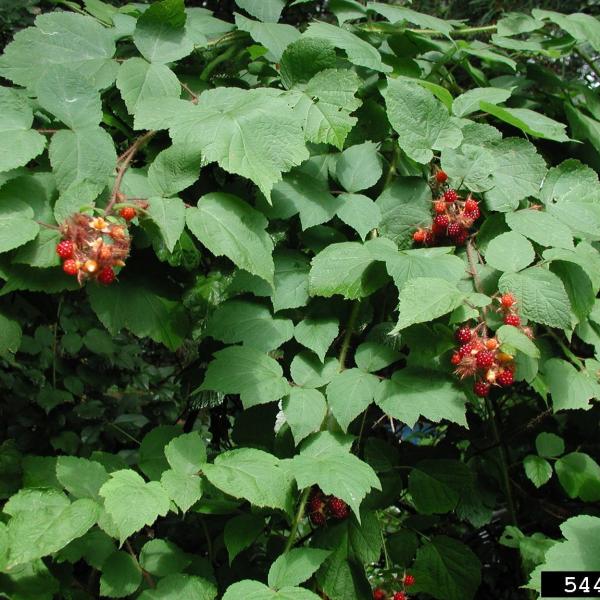
Wineberry (Rubus phoenicolasius), also commonly known as wine raspberry, dewberry, and Japanese raspberry, is a perennial, deciduous shrub that is a member of the rose family (Rosaceae) and shares many characteristics of its close relatives in the genus Rubus, such as raspberries and blackberries. Like raspberry, wineberry has silvery underleaves, a fruit core that remains on the stem when the ripe fruit is picked, and thorns. It is differentiated from other similar species by the fine red hairs that grow densely on its stems and flowers, giving the plant a reddish hue. Its fruit is edible, sweet and somewhat tart, and is a sought- after ingredient in many baking and cocktail recipes.
Background
Wineberry is native to parts of Japan, Korea, and China, and was first introduced to the United States in the 1890s as breeding stock for raspberries. Because of this plant’s highly desirable fruit, resistance to native pests, and high tolerance for varied site conditions, it is still used today by horticulturists, home gardeners, and berry breeders. However, the qualities that make this plant a highly competitive and hardy berry variety also contribute to its invasive characteristics in its current North American range. It is listed as invasive in many eastern U.S. states, including New York, Maryland, Pennsylvania, Tennessee, Virginia, North Carolina, West Virginia, and the District of Columbia. It was declared a Plant Pest in 2024 by the Vermont Agency of Agriculture, Food and Markets, which prohibits the import, sale, or movement of this plant.
Habitat and Distribution
In the U.S., wineberry was found to have escaped cultivation and become an invasive weed by the 1970s; since then, it has spread and been recorded in most states east of the Mississippi River. Wineberry has a wide range of tolerance for light, soil type, and moisture level, and is hardy to USDA Zone 5 (annual minimum temperatures to -20F). Although it is most productive in edge habitat and disturbed sites, it is shade tolerant can be found in most habitat types, including forest understories. The extent to which wineberry associates with different plant communities has not yet been widely studied in Vermont, but wineberry forms associations with a wide range of plant communities in the southern portion of its range where it has been established for longer periods of time. The website iNaturalist.org has three research grade confirmed reports of wineberry in Vermont; because of its limited statewide distribution, it has been identified as an early detection terrestrial plant species by VTInvasives.org. Members of the public are encouraged to report wineberry observations on the website’s Report It! page.
Biology and Spread
Like the closely related raspberries and blackberries, wineberry is a perennial shrub with stems that grow in long shoots. These canes can grow up to 6-9 ft long per season, and re-root at the tips when they touch the ground. Wineberry canes grow in two stages; in the first year they form a vegetative cane, and in the second year the cane becomes woody and produces lateral branches, flowers, and fruit. While the canes each live two years, the plant produces new canes every year. Leaves are produced in April, flowers in May, and fruit from late June to August; leaves drop in late November. Wineberry does not need pollen from another individual to set seed, and therefore may reproduce more easily than its native berry relatives. Seeds are readily eaten and dispersed by many animal species, and wineberry plants can also reproduce vegetatively from root nodes as well as from canes touching the ground.
Ecological Concern
Wineberry can form dense, impenetrable thickets in natural areas, and similar to its native rubus relatives, often colonizes disturbed sites such as forest clearings where the canopy has been opened. However, it is more competitive than native raspberry and blackberry species and has a wider range of tolerance for light conditions, moisture level, and soil type. Wineberry thickets impede natural succession because they persist for longer and are able to spread into mature forest understories more than their native relatives. Once established, wineberry can shade out native understory plants such as tree saplings, impacting forest regeneration. Because wineberry outcompetes similar native species, it also reduces the biodiversity and wildlife habitat value of natural areas. In addition, its persistent, tall, dense thickets of vegetation make travel difficult and can therefore greatly reduce the recreational value of an area.
Identification
Stems: Long shoots/canes are vegetative in the first year, woody in the second. The stems/petioles are covered in red thorns and fine hairs.
Leaves: Alternate, divided into three leaflets, broadly ovate with pointed tips, serrated margins, undersides silvery white with dense hairs.
Flowers: Five white heart-shaped petals surrounded by five longer hairy green sepals. The arrangement of sepals is distinctly star-shaped.
Fruit/Seeds: Clusters of druplets (small parts of an aggregate fruit containing a single seed) ½” in diameter, shiny red with hollow centers.
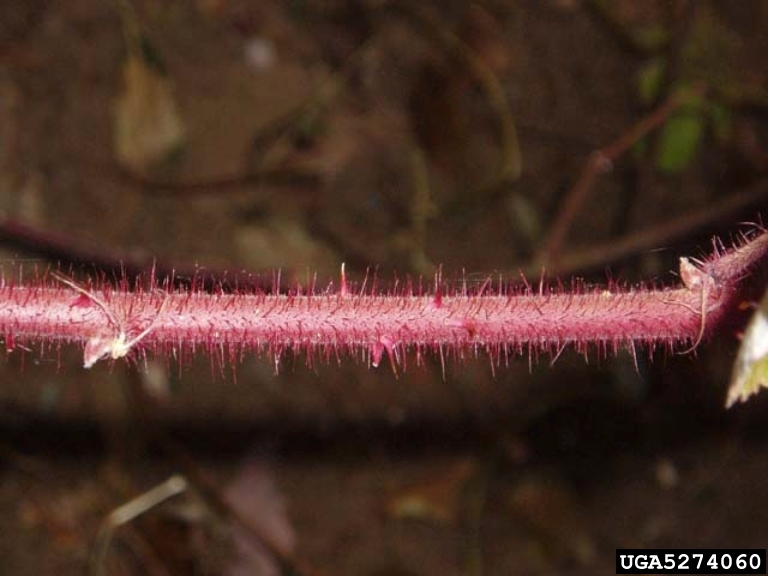
Stems: Long shoots/canes are vegetative in the first year, woody in the second. The stems/petioles are covered in red thorns and fine hairs.
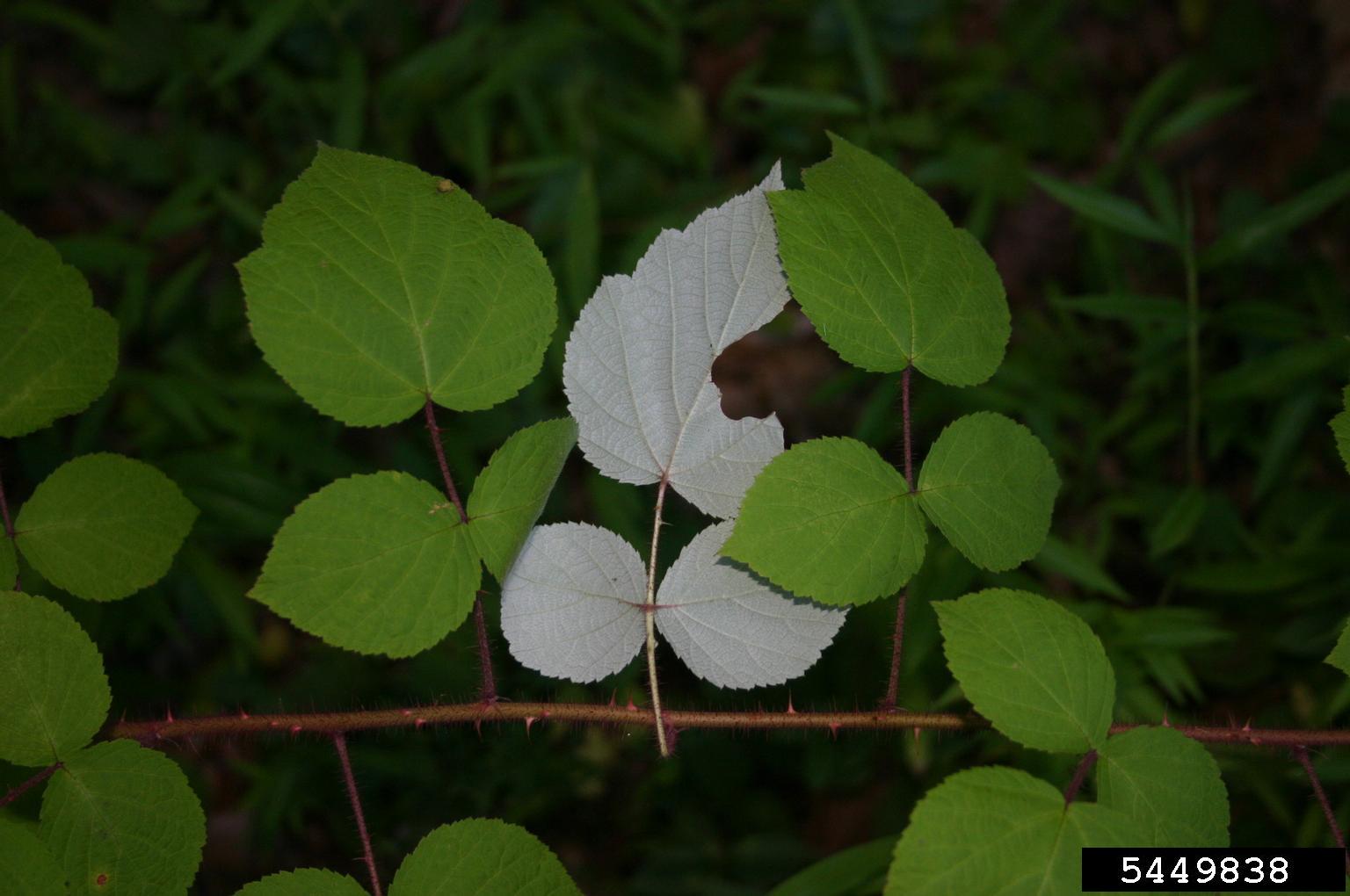
Leaves: Alternate, divided into three leaflets, broadly ovate with pointed tips, serrated margins, undersides silvery white with dense hairs.
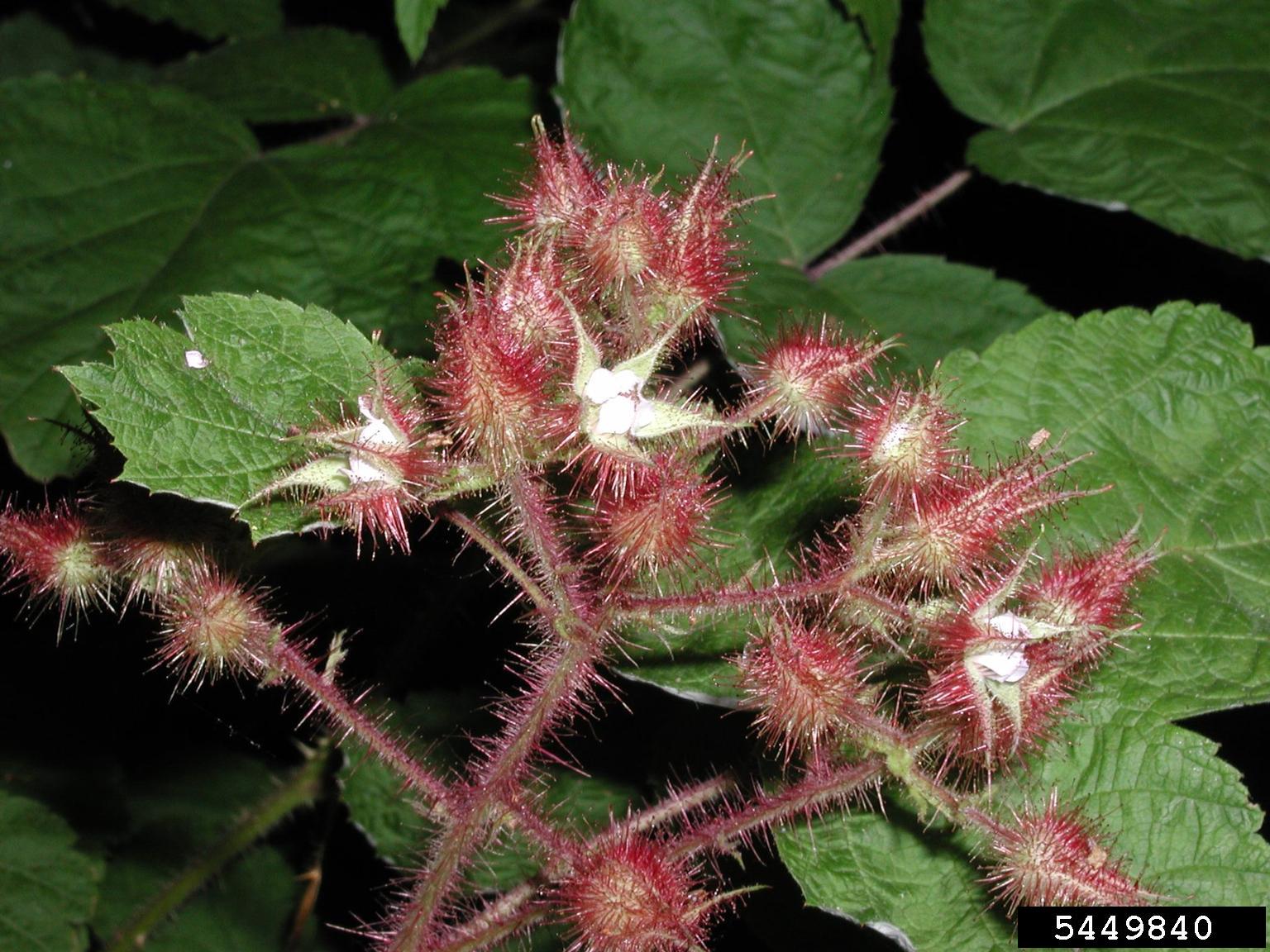
Flowers: Five white heart-shaped petals surrounded by five longer hairy green sepals. The arrangement of sepals is distinctly star-shaped.
Management
For any invasive species control project, it is important to have a plan for the location before control begins. Disturbance without replanting often results in the return of either the same invasive species or other invasives to the site; have a restoration plan in place before starting invasive species removal.
Mechanical Control
Although any root fragments may propagate new plants, wineberry does not have a vigorous underground root structure; this makes hand pulling or digging a more successful strategy than for some perennial invasive shrubs. Because wineberry is covered with thorns and spiny hairs,
minimize skin contact during removal. A weed wrench or a pronged digging fork can be effective for pulling out whole plants and root systems. Repeated efforts over a few years will be necessary to remove plants that resprout from root fragments.
Chemical Control
Wineberry can be controlled using systemic herbicides such as glyphosate or triclopyr. A foliar spray method of application can be useful in covering large or dense stands of vegetation but presents an increased likelihood for off-target impacts via herbicide spray drift. Conduct applications with little to no wind and an appropriate droplet size and spray pressure to minimize these risks. For smaller infestations, a more labor- intensive cut stump application method may be effective if it is timed later in the season; in the fall, plants are transporting their energy reserves to the root system, which aides in translocation of the herbicide. As with all pesticide use, follow all label application instructions and precautions, and wear appropriate personal protective equipment. The label is the law.
Native Lookalikes
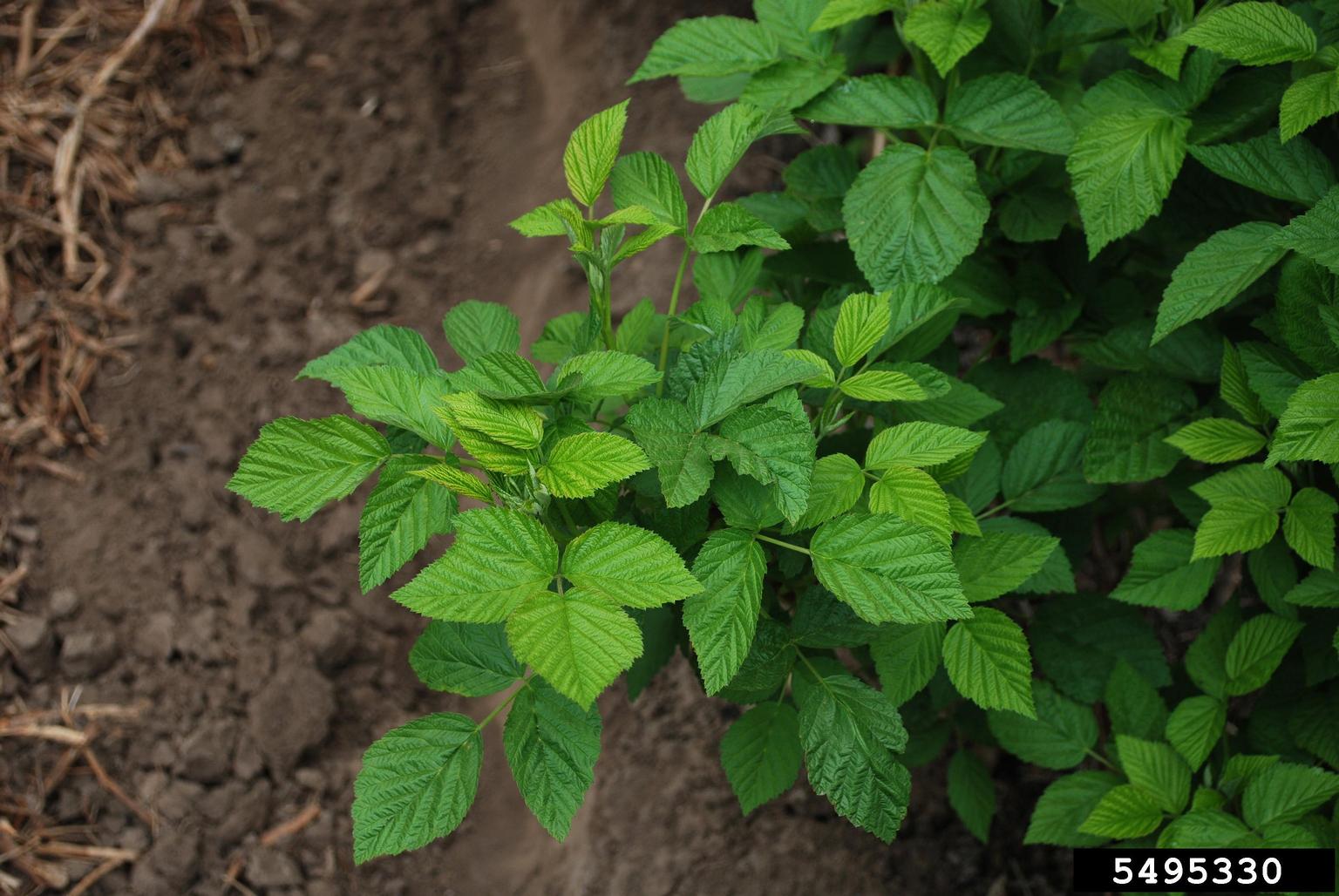
American red raspberry (Rubus idaeus). Note the lack of fine red hairs on the stems and petioles.
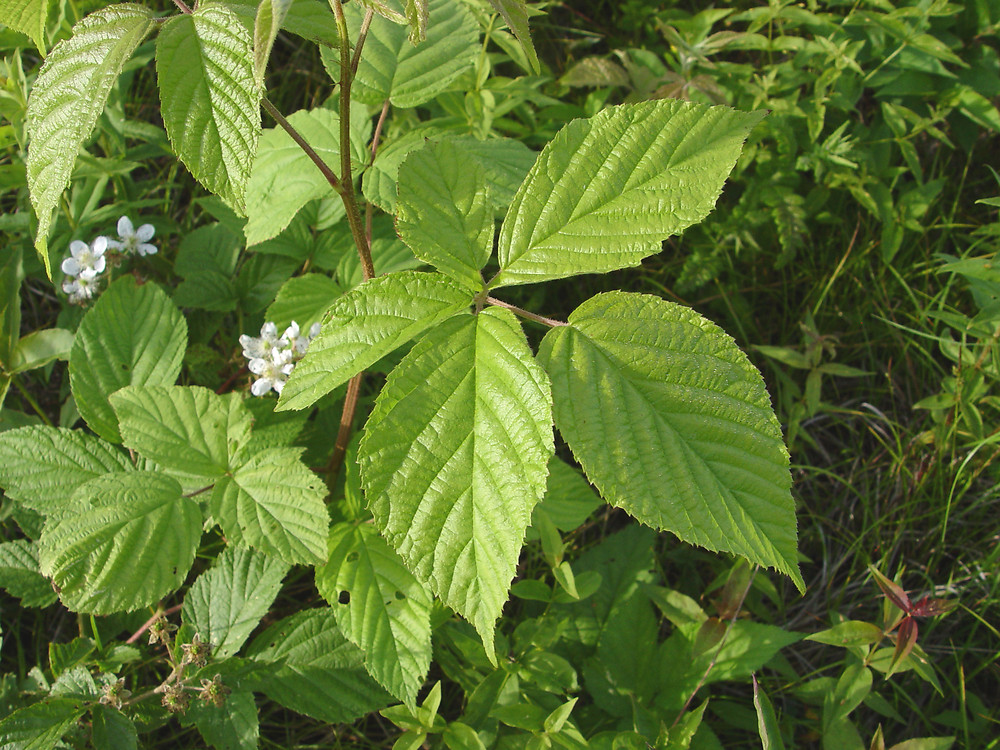
Common blackberry (Rubus allegheniensis). Note the pale green stem and smaller flower sepals. Credit: Donald Cameron
Photo Credits: Wineberry, 5449838, 5274060, Leslie Mehrhoff, Bugwood.org